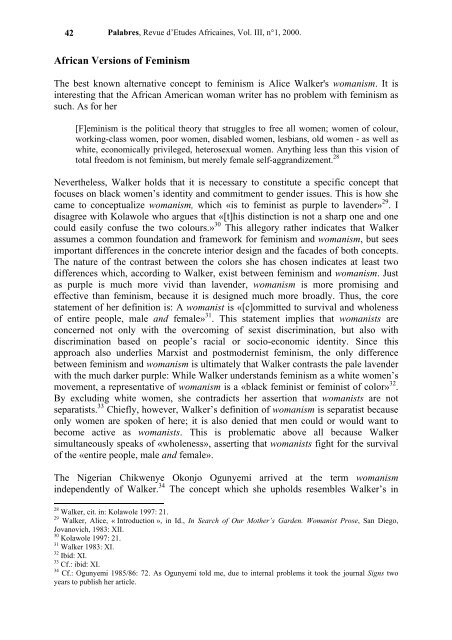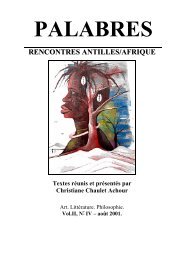- Page 1 and 2: PALABRES FEMMES ET T CREATIONS LITT
- Page 5: Revue d’Etudes Africaines /Africa
- Page 8 and 9: Kangni Alemdjrodo LE CORPS DU SEXE.
- Page 11 and 12: D PRESENTATION FEMMES ET CREATIONS
- Page 13 and 14: Sélom K. Gbanou : Femmes et créat
- Page 15 and 16: Sélom K. Gbanou : Femmes et créat
- Page 17 and 18: Sélom K. Gbanou : Femmes et créat
- Page 19 and 20: Sélom K. Gbanou : Femmes et créat
- Page 21 and 22: Sélom K. Gbanou : Femmes et créat
- Page 23: Sélom K. Gbanou : Femmes et créat
- Page 26 and 27: 26 Palabres, Revue d’Etudes Afric
- Page 28 and 29: 28 Palabres, Revue d’Etudes Afric
- Page 30 and 31: 30 Palabres, Revue d’Etudes Afric
- Page 32 and 33: 32 Palabres, Revue d’Etudes Afric
- Page 35 and 36: «WHO IS AFRAID OF FEMINISM?» 1 CR
- Page 37 and 38: ARNDT Susan : « Who is afraid of F
- Page 39 and 40: ARNDT Susan : « Who is afraid of F
- Page 41: ARNDT Susan : « Who is afraid of F
- Page 45 and 46: ARNDT Susan : « Who is afraid of F
- Page 47 and 48: ARNDT Susan : « Who is afraid of F
- Page 49 and 50: ARNDT Susan : « Who is afraid of F
- Page 51 and 52: ARNDT Susan : « Who is afraid of F
- Page 53 and 54: ARNDT Susan : « Who is afraid of F
- Page 55 and 56: ARNDT Susan : « Who is afraid of F
- Page 57 and 58: ARNDT Susan : « Who is afraid of F
- Page 59 and 60: ARNDT Susan : « Who is afraid of F
- Page 61: ARNDT Susan : « Who is afraid of F
- Page 64 and 65: 64 Palabres, Revue d’Etudes Afric
- Page 66 and 67: 66 Palabres, Revue d’Etudes Afric
- Page 68 and 69: 68 Palabres, Revue d’Etudes Afric
- Page 70 and 71: 70 Palabres, Revue d’Etudes Afric
- Page 72 and 73: 72 Palabres, Revue d’Etudes Afric
- Page 74 and 75: 74 Palabres, Revue d’Etudes Afric
- Page 76 and 77: 76 Palabres, Revue d’Etudes Afric
- Page 78 and 79: 78 Palabres, Revue d’Etudes Afric
- Page 80 and 81: 80 Palabres, Revue d’Etudes Afric
- Page 82 and 83: 82 Palabres, Revue d’Etudes Afric
- Page 84 and 85: 84 Palabres, Revue d’Etudes Afric
- Page 86 and 87: 86 Palabres, Revue d’Etudes Afric
- Page 88 and 89: 88 Palabres, Revue d’Etudes Afric
- Page 90 and 91: 90 Palabres, Revue d’Etudes Afric
- Page 92 and 93:
92 Palabres, Revue d’Etudes Afric
- Page 94 and 95:
94 Palabres, Revue d’Etudes Afric
- Page 96 and 97:
96 Palabres, Revue d’Etudes Afric
- Page 98 and 99:
98 Palabres, Revue d’Etudes Afric
- Page 100 and 101:
100 Palabres, Revue d’Etudes Afri
- Page 102 and 103:
102 Palabres, Revue d’Etudes Afri
- Page 104 and 105:
104 Palabres, Revue d’Etudes Afri
- Page 106 and 107:
106 Palabres, Revue d’Etudes Afri
- Page 108 and 109:
108 Palabres, Revue d’Etudes Afri
- Page 110 and 111:
110 Palabres, Revue d’Etudes Afri
- Page 112 and 113:
112 Palabres, Revue d’Etudes Afri
- Page 114 and 115:
114 Palabres, Revue d’Etudes Afri
- Page 116 and 117:
116 Palabres, Revue d’Etudes Afri
- Page 118 and 119:
118 Palabres, Revue d’Etudes Afri
- Page 120 and 121:
2 3 4 1 2 3 120 Palabres, Revue d
- Page 122 and 123:
122 Palabres, Revue d’Etudes Afri
- Page 124 and 125:
124 Palabres, Revue d’Etudes Afri
- Page 126 and 127:
126 Palabres, Revue d’Etudes Afri
- Page 129 and 130:
LE CORPS DU SEXE. SEXUALITE ET TEXT
- Page 131 and 132:
ALEMDJRODO Kangni : Le corps du sex
- Page 133 and 134:
ALEMDJRODO Kangni : Le corps du sex
- Page 135 and 136:
ALEMDJRODO Kangni : Le corps du sex
- Page 137:
ALEMDJRODO Kangni : Le corps du sex
- Page 140 and 141:
140 Palabres, Revue d’Etudes Afri
- Page 142 and 143:
142 Palabres, Revue d’Etudes Afri
- Page 144 and 145:
144 Palabres, Revue d’Etudes Afri
- Page 146 and 147:
146 Palabres, Revue d’Etudes Afri
- Page 148 and 149:
148 Palabres, Revue d’Etudes Afri
- Page 150 and 151:
150 Palabres, Revue d’Etudes Afri
- Page 152 and 153:
152 Palabres, Revue d’Etudes Afri
- Page 154 and 155:
154 Palabres, Revue d’Etudes Afri
- Page 156 and 157:
156 Palabres, Revue d’Etudes Afri
- Page 158 and 159:
158 Palabres, Revue d’Etudes Afri
- Page 160 and 161:
160 Palabres, Revue d’Etudes Afri
- Page 162 and 163:
162 Palabres, Revue d’Etudes Afri
- Page 164 and 165:
164 Palabres, Revue d’Etudes Afri
- Page 166 and 167:
166 Palabres, Revue d’Etudes Afri
- Page 168 and 169:
168 Palabres, Revue d’Etudes Afri
- Page 170 and 171:
170 Palabres, Revue d’Etudes Afri
- Page 172 and 173:
172 Palabres, Revue d’Etudes Afri
- Page 174 and 175:
174 Palabres, Revue d’Etudes Afri
- Page 176 and 177:
176 Palabres, Revue d’Etudes Afri
- Page 178 and 179:
178 La quête identitaire Palabres,
- Page 180 and 181:
180 Palabres, Revue d’Etudes Afri
- Page 182 and 183:
182 Palabres, Revue d’Etudes Afri
- Page 184 and 185:
184 Palabres, Revue d’Etudes Afri
- Page 186 and 187:
186 Palabres, Revue d’Etudes Afri
- Page 188 and 189:
188 Palabres, Revue d’Etudes Afri
- Page 191 and 192:
DU MASCULIN ET DU FEMININ DANS LES
- Page 193 and 194:
DEJEAN DE LA BATIE B. : Du masculin
- Page 195 and 196:
DEJEAN DE LA BATIE B. : Du masculin
- Page 197 and 198:
DEJEAN DE LA BATIE B. : Du masculin
- Page 199 and 200:
DEJEAN DE LA BATIE B. : Du masculin
- Page 201 and 202:
DEJEAN DE LA BATIE B. : Du masculin
- Page 203 and 204:
GISELE PINEAU OU UNE NOUVELLE VOIX
- Page 205 and 206:
DUMONTET Danielle : Gisèle Pineau
- Page 207 and 208:
DUMONTET Danielle : Gisèle Pineau
- Page 209 and 210:
DUMONTET Danielle : Gisèle Pineau
- Page 211 and 212:
DUMONTET Danielle : Gisèle Pineau
- Page 213 and 214:
DUMONTET Danielle : Gisèle Pineau
- Page 215 and 216:
DUMONTET Danielle : Gisèle Pineau
- Page 217:
DUMONTET Danielle : Gisèle Pineau
- Page 220 and 221:
220 Palabres, Revue d’Etudes Afri
- Page 222 and 223:
222 Palabres, Revue d’Etudes Afri
- Page 225 and 226:
LA MEMOIRE PARLE: A PROPOS DE LA ME
- Page 227 and 228:
ZEKRI Khalid : La mémoire parle :
- Page 229 and 230:
ZEKRI Khalid : La mémoire parle :
- Page 231:
ZEKRI Khalid : La mémoire parle :
- Page 234 and 235:
234 Palabres, Revue d’Etudes Afri
- Page 236 and 237:
236 Palabres, Revue d’Etudes Afri
- Page 238 and 239:
238 Palabres, Revue d’Etudes Afri
- Page 240 and 241:
240 Palabres, Revue d’Etudes Afri
- Page 242 and 243:
242 Palabres, Revue d’Etudes Afri
- Page 244 and 245:
244 Palabres, Revue d’Etudes Afri
- Page 247 and 248:
U LA LETTRE : GENRE FEMININ OU UNE
- Page 249 and 250:
CABAKULU Mwamba : La Lettre : genre
- Page 251 and 252:
CABAKULU Mwamba : La Lettre : genre
- Page 253:
CABAKULU Mwamba : La Lettre : genre
- Page 256 and 257:
256 Palabres, Revue d’Etudes Afri
- Page 258 and 259:
258 Palabres, Revue d’Etudes Afri
- Page 260 and 261:
260 Palabres, Revue d’Etudes Afri
- Page 262 and 263:
262 Palabres, Revue d’Etudes Afri
- Page 264 and 265:
264 Palabres, Revue d’Etudes Afri
- Page 266 and 267:
266 Palabres, Revue d’Etudes Afri
- Page 268 and 269:
268 Palabres, Revue d’Etudes Afri
- Page 270 and 271:
270 Palabres, Revue d’Etudes Afri
- Page 272 and 273:
272 Palabres, Revue d’Etudes Afri
- Page 274 and 275:
274 Palabres, Revue d’Etudes Afri
- Page 276 and 277:
276 Palabres, Revue d’Etudes Afri
- Page 278 and 279:
278 Palabres, Revue d’Etudes Afri
- Page 280 and 281:
280 Palabres, Revue d’Etudes Afri
- Page 282 and 283:
282 Palabres, Revue d’Etudes Afri
- Page 284 and 285:
284 Palabres, Revue d’Etudes Afri
- Page 286 and 287:
286 Palabres, Revue d’Etudes Afri
- Page 288 and 289:
288 Palabres, Revue d’Etudes Afri
- Page 291 and 292:
LE TRAVAIL DE L’ECRITURE OU COMME
- Page 293 and 294:
Amela Yao Edo Amelavi : Le travail
- Page 295 and 296:
Amela Yao Edo Amelavi : Le travail
- Page 297 and 298:
Amela Yao Edo Amelavi : Le travail
- Page 299 and 300:
Amela Yao Edo Amelavi : Le travail
- Page 301:
Amela Yao Edo Amelavi : Le travail
- Page 304 and 305:
304 Palabres, Revue d’Etudes Afri
- Page 306 and 307:
306 L Palabres, Revue d’Etudes Af
- Page 308 and 309:
308 Palabres, Revue d’Etudes Afri
- Page 310 and 311:
L Christiane Chaulet-Achour, Noûn
- Page 312 and 313:
Fiche d'adhésion et d’abonnement
- Page 314 and 315:
Volume III, n°1&2 Femmes et Créat
- Page 316:
PALABRES VOL.III, n°1&2 FEMMES ET



